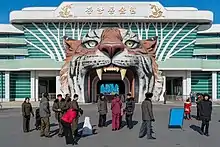| Korea Central Zoo | |
|---|---|
 | |
| 39°04′30″N 125°48′54″E / 39.07500°N 125.81500°E | |
| Date opened | April 1959 |
| Location | Taesŏng-guyŏk, Pyongyang, North Korea |
| Land area | 1 km2 (250 acres) |
| No. of animals | 5000+ |
| No. of species | 650 |
| Public transit access | |
| Korean name | |
| Chosŏn'gŭl | 조선중앙동물원 |
|---|---|
| Hancha | 朝鮮中央動物園 |
| Revised Romanization | Joseon Jung-ang Dongmulwon |
| McCune–Reischauer | Chosǒn Chung'ang Tongmulwǒn |
The Korea Central Zoo, also referred to as the Pyongyang Central Zoo, is the national zoo of North Korea. It is located near Taesŏngsan mountain in downtown Pyongyang. The zoo has over 5,000 wild animals, comprising a total of 650 species, and covers an area of roughly one square kilometre. It was reportedly established in April 1959 at the instruction of Kim Il Sung.[1][2]
Attractions
Elephants at the zoo are said to be one of the chief attractions; all the elephants are descended from the family of a single "hero elephant" given to Kim Il Sung by Ho Chi Minh in 1959.[3] However, as of 2001, the zoo kept a variety of non-indigenous species of animals, including 400 given as gifts by heads of state and other foreign citizens.[3] A significant number of those were the gift of a single Swedish citizen, Jonas Wahlström, director of the Skansen Aquarium; they are housed in the Animal Museum, which opened as a new exhibit in 1985.[4] According to a report by The Daily Telegraph, the zoo also has a parrot that can squawk "Long live the Great Leader, Comrade Kim Il Sung" in English.[5] The Central Zoo conducted its first zoo exchange with South Korean zoos in April 2005, in which they received llamas and hippopotamuses, among other species of animals. Many of the animals sent south, which included Asiatic black bears, African ponies, and Siberian weasels, were first quarantined by South Korea before being shipped to their destinations.[6]
The Central Zoo also has dogs on display for visitors to see, including eight raised by Kim Il Sung and given to the zoo after his death in 1994.[7] A pair of Jindo dogs given by Kim Dae-jung to Kim Jong Il at their 2000 summit were also kept at the zoo; they produced a litter of five puppies in September 2001.[8]
The zoo also stars a cigarette-smoking chimpanzee called Azalea, basketball-playing monkeys, doves that are part of a figure skating routine, and a dog who is trained to manipulate an abacus.[9]
In 2010, the zoo, along with several others in North Korea, was restocked with wildlife from Hwange National Park in Zimbabwe. Conservationists in the country condemned the deal, fearing the animals would not survive the long trip or the conditions in North Korea's zoos. Zimbabwean authorities sent veterinary experts to the zoo and were satisfied with the conditions there.[10]
Criticisms
The Central Zoo has been criticised by Lonely Planet and Asia Times. The Lonely Planet travel guide for Korea described it as a "depressing and uninspiring place, best avoided".[11] A 2006 report in the Asia Times described a North Korean movie entitled Fighting Animals, purporting to be a nature documentary, showing caged animals, often of different species, fighting each other to the death. The report noted that many of the animal species portrayed, which included endangered species, were only kept at the Central Zoo and nowhere else in North Korea; on this basis, they accused zookeepers there of being complicit in the production of the film, including placing animals of different species into the same cage and goading them to attack each other.[12]
References
- ↑ "Central Zoo, Center for Cultural and Emotional Life". Korean Central News Agency. 2 August 2006. Archived from the original on 26 September 2007. Retrieved 18 July 2007.
- ↑ 선물동물-흰범. Korean Central News Agency (in Korean). 22 June 2004. Archived from the original on 8 October 2007. Retrieved 18 July 2007.
- 1 2 "Gift animals". Korean Central News Agency. 20 July 2001. Archived from the original on 10 October 2007. Retrieved 18 July 2007.
- ↑ "Animal Museum of Central Zoo in DPRK". Korean Central News Agency. 25 September 2006. Archived from the original on 8 October 2007. Retrieved 18 July 2007.
- ↑ Kershaw, Andy (20 March 2003). "North Korea: The paranoid state". The Daily Telegraph. Archived from the original on 21 April 2013. Retrieved 18 July 2007.
- ↑ Brooke, James (15 May 2005). "A quarantine: Definitions differ in Seoul and the U.S." International Herald Tribune. Retrieved 18 July 2007.
- ↑ Kang, Chol-hwan (5 November 2000). "Dogs Are Hard to Find in Pyongyang". The Chosun Ilbo. Archived from the original on 26 June 2006. Retrieved 18 July 2007.
- ↑ "Exchanged Dogs Pup '2nd Generation' in Pyongyang and Seoul". The People's Korea (169). 3 November 2001. Archived from the original on 27 September 2007. Retrieved 18 July 2007.
- ↑ Simon, Johnny (19 October 2016). "The star of the Pyongyang zoo is a chain-smoking chimp". Quartz. Retrieved 19 October 2016.
- ↑ "'Noah's Ark' deal row rages on". TimesLIVE. Archived from the original on 4 December 2013. Retrieved 2 February 2022.
- ↑ Bender, Andrew (2004). Lonely Planet: Korea. Lonely Planet. p. 349. ISBN 1-74059-449-5.
- ↑ Card, James (28 January 2006). "North Korea: Red in tooth and claw". Asia Times. Archived from the original on 6 February 2006. Retrieved 18 July 2007.
{{cite news}}: CS1 maint: unfit URL (link)
External links
- The Central Zoo picture album at Naenara
- Gift Animals at Central Zoo picture album at Naenara
- Another picture album at Naenara
- North Korea - Central Zoo Pyongyang on YouTube
- Pyongyang zoo on YouTube
- North Korea: Pyongyang Central Zoo on YouTube